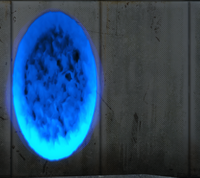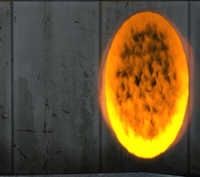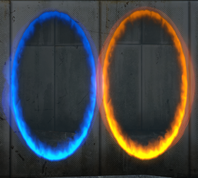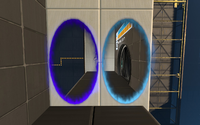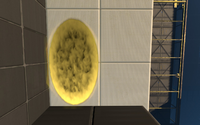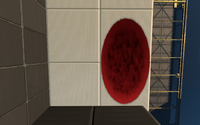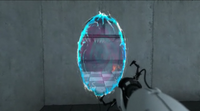|
|
| Line 5: |
Line 5: |
|
| |
|
| == Overview == | | == Overview == |
| In ''[[Portal]]'' and the single-player campaign of ''[[Portal 2]]'', protagonist and test subject [[Chell]] can create blue (primary-fire) and orange (secondary-fire) portals with her version of the Portal Gun. In ''Portal 2''<nowiki>'</nowiki>s [[co-op]] campaign, each robot test subject possesses individual portal colors in order to differentiate them; [[Atlas]] creates cyan (primary) and purple (secondary) portals, whereas [[P-body]] creates yellow (primary) and red (secondary) portals.
| |
|
| |
|
| Lone (unlinked) portals appear as solid-colored ovals, and paired (linked) portals appear as color-bordered ovals - with the rift forming into a mirrored view from the other portal. Portals are known for maintaining the mass and velocity of any object that passes through one portal and exits out the other. Portals are also capable of maintaining the flow of light and gravity, specifically the [[Excursion Funnel]]s and [[Hard Light Bridge]]s. With few exceptions, portals will disappear if the surface they are placed on moves.
| | Portals in a pair act as a direct link between one another. Anything that goes into one portal comes instantly out the other. Objects going at high speed into a portal (such as falling into one from great height) will maintain their speed when coming out of the other, giving the player the ability to launch themselves or other objects through the air. Portals are also capable of continuing any sort of beam, specifically the [[Excursion Funnel]]s, [[Thermal Discouragement Beam]]s, and [[Hard Light Bridge]]s. If only one portal in a pair exists at the moment, the existing portal is an oval completely filled in with color. When attempting to enter an unpaired portal, it will act as a solid wall. When both portals in a pair exist, they will appear to be like windows. When looking through one portal, you can see directly out the other. When a portal is linked, you can identify which portal it is by looking at its colored border. |
| | |
| | Once the player obtains the Portal Device, they can create a portal on a surface by aiming at the spot they want to put the portal and pressing the primary or secondary fire key. If the player has only acquired the Single Portal Device, both fire keys produce the primary portal color. If they have acquired the Dual Portal Device, the primary fire key produces the primary color and the secondary fire key produces the secondary color. Portals cannot be placed on surfaces that are not made of the appropriate material (white walls usually indicate this material), moving, not flat, or not large enough for a portal to fit onto it. Portals also cannot be placed while looking through currently existing portals. |
| | |
| | In ''[[Portal]]'' and the single-player campaign of ''[[Portal 2]]'', protagonist and test subject [[Chell]] can create blue (primary) and orange (secondary) portals with her version of the Dual Portal Gun. In ''Portal 2''<nowiki>'</nowiki>s [[co-op]] campaign, each robot test subject possesses individual portal colors in order to differentiate them; [[Atlas]] creates cyan (primary) and purple (secondary) portals, whereas [[P-body]] creates yellow (primary) and red (secondary) portals. |
|
| |
|
| === Pre-release designs === | | === Pre-release designs === |
Revision as of 22:28, 16 June 2015
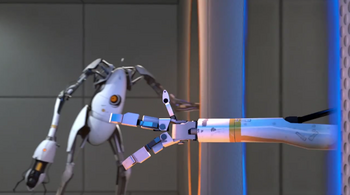
A curious
P-body testing and playing with the Portal Gun.
| “ |
Momentum, a function of mass and velocity, is conserved between portals. In layman's terms: Speedy-thing goes in, speedy-thing comes out.
— GLaDOS
|
” |
Portals are the primary gameplay mechanic of the Portal series. Portals can only be placed on flat surfaces by a Handheld Portal Device (simply referred to as a Portal Gun), and works in pairs thereby allowing two-way movement through each portal.
Overview
Portals in a pair act as a direct link between one another. Anything that goes into one portal comes instantly out the other. Objects going at high speed into a portal (such as falling into one from great height) will maintain their speed when coming out of the other, giving the player the ability to launch themselves or other objects through the air. Portals are also capable of continuing any sort of beam, specifically the Excursion Funnels, Thermal Discouragement Beams, and Hard Light Bridges. If only one portal in a pair exists at the moment, the existing portal is an oval completely filled in with color. When attempting to enter an unpaired portal, it will act as a solid wall. When both portals in a pair exist, they will appear to be like windows. When looking through one portal, you can see directly out the other. When a portal is linked, you can identify which portal it is by looking at its colored border.
Once the player obtains the Portal Device, they can create a portal on a surface by aiming at the spot they want to put the portal and pressing the primary or secondary fire key. If the player has only acquired the Single Portal Device, both fire keys produce the primary portal color. If they have acquired the Dual Portal Device, the primary fire key produces the primary color and the secondary fire key produces the secondary color. Portals cannot be placed on surfaces that are not made of the appropriate material (white walls usually indicate this material), moving, not flat, or not large enough for a portal to fit onto it. Portals also cannot be placed while looking through currently existing portals.
In Portal and the single-player campaign of Portal 2, protagonist and test subject Chell can create blue (primary) and orange (secondary) portals with her version of the Dual Portal Gun. In Portal 2's co-op campaign, each robot test subject possesses individual portal colors in order to differentiate them; Atlas creates cyan (primary) and purple (secondary) portals, whereas P-body creates yellow (primary) and red (secondary) portals.
Pre-release designs
The portals have had several changes in design before the final release of Portal in October 10, 2007, as evident in some trailers and screenshots.[1] Even Earlier development screenshots from Portal revealed that the original colors for the portals were light blue (primary-fire) and purple (secondary-fire), with the portals more resembling like rifts ripped into a dimension than the simpler oval designs in the current series. Later, the purple color was replaced with red, akin to P-Body's secondary-fire in Portal 2. At some point, the developers decided to maintain the blue and orange color schemes previously used as portals in Narbacular Drop.
Gameplay bugs
- Portal boosting: A player is able to boost their momentum when traveling through two portals placed on the floor by using their primary or secondary fire key as they exit the primary or secondary portal, respectively. This is caused by the portals pushing the player away from a portal if the portal is re-placed somewhere else (or in this case, in the same place).
Gallery
Portal colors
Pre-release designs
| Chell's portals |
| A dated screenshot from the Steam Store depicting early portals, now bearing a proper oval shape.
|
|
References

